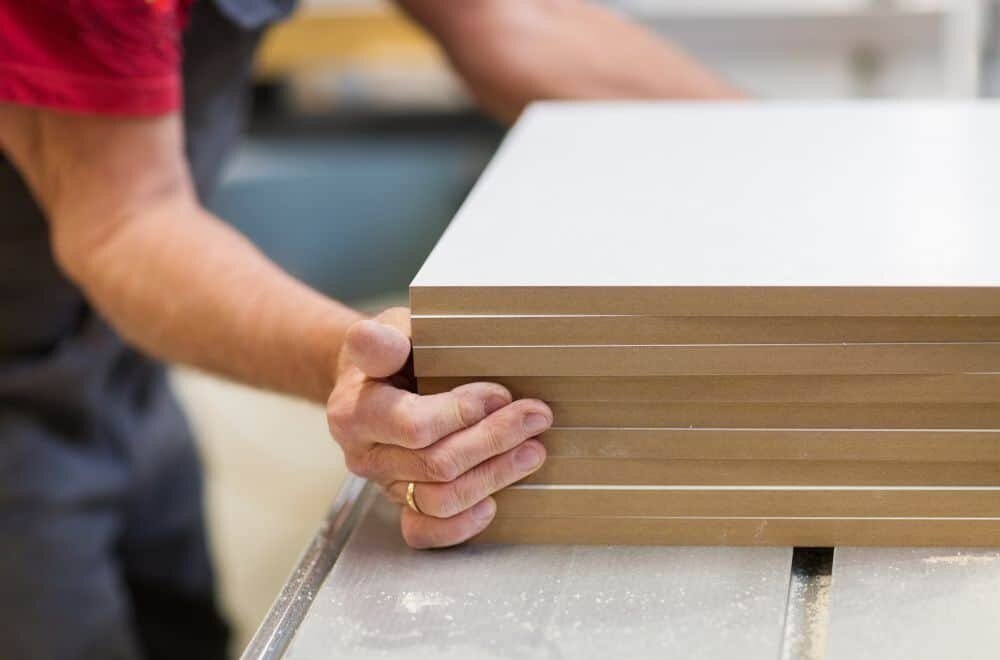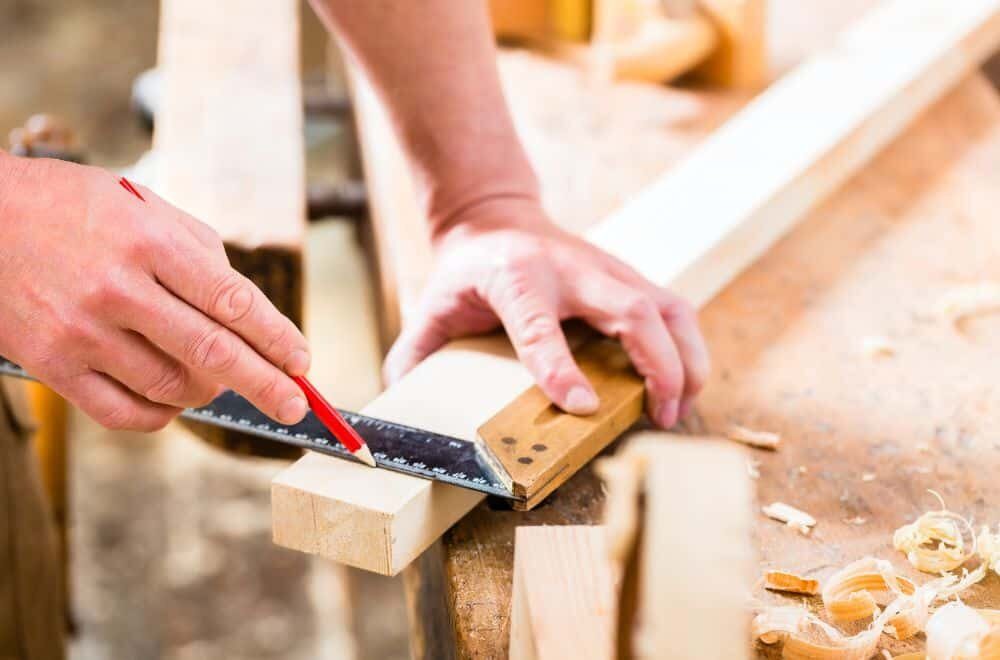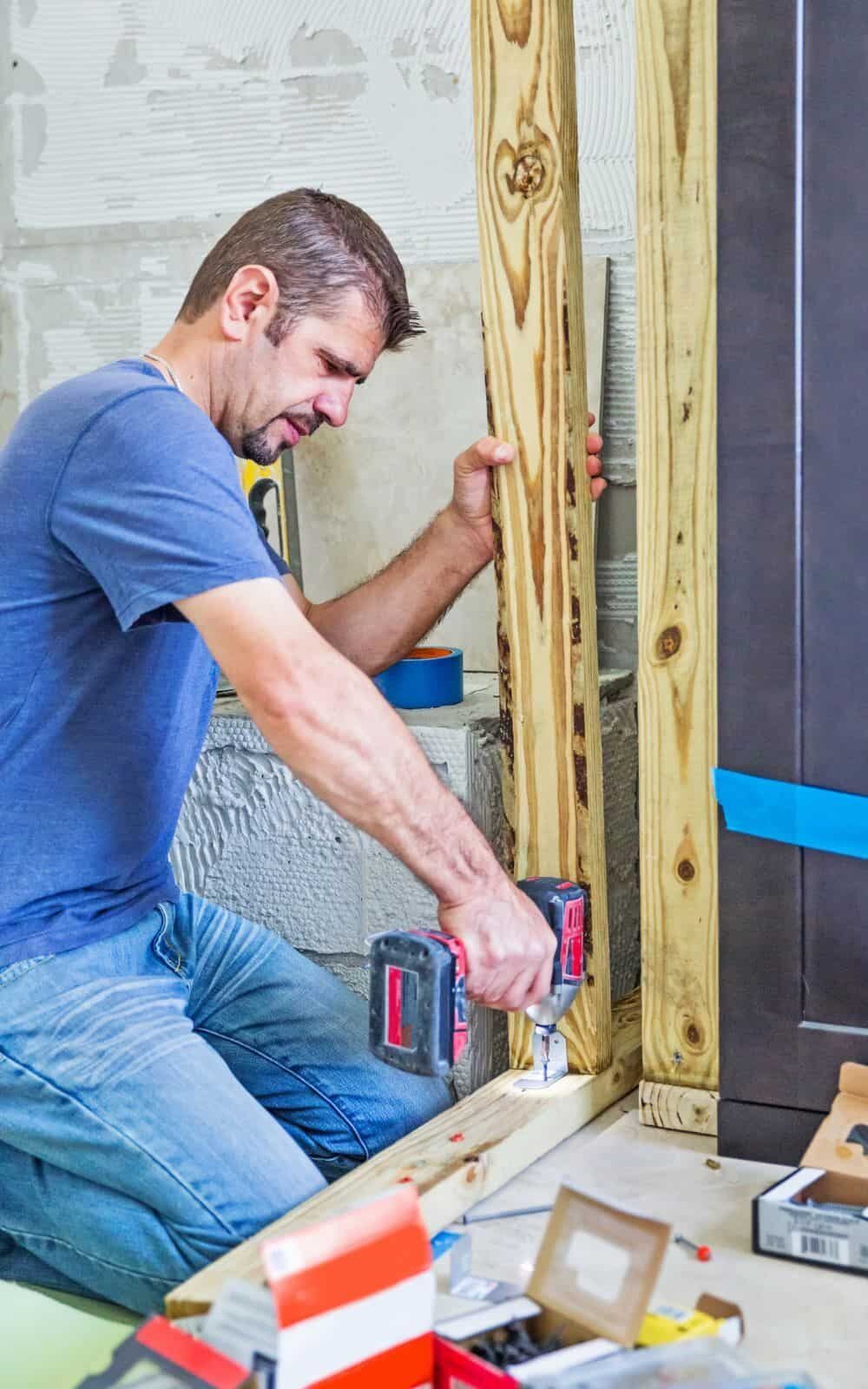Hanging a thin piece of wood on a wall can be a tricky task, especially if you want to ensure that it is secure and won’t fall off. There are several methods that you can use to hang a thin piece of wood on a wall, such as using adhesive, double-sided tape, or wire. However, it is important to choose the right method based on the weight of the wood and the type of wall you are hanging it on.
One popular method for hanging a thin piece of wood on a wall is using a French cleat. This involves cutting a 45-degree bevel on a piece of hardwood, which is then attached to the wall. The other half of the cleat is attached to the back of the wood, allowing it to slide onto the cleat and be held securely in place. This method is particularly useful for heavy pieces of wood that need to be securely attached to the wall.
Another option for hanging a thin piece of wood on a wall is using velcro wall hangers. These hangers are designed to hold lightweight items, such as pictures or posters, but can also be used for thin pieces of wood. They are easy to install and remove, making them a good choice if you want to change the position of the wood frequently. However, they may not be suitable for heavier pieces of wood.
Understanding Wall Types

When it comes to hanging a thin piece of wood on a wall, it’s important to understand the type of wall you are working with. Different wall types require different methods of hanging, and using the wrong method can result in damage to your wall or your artwork. Here are some common wall types and the best ways to hang a thin piece of wood on them.
Drywall
Drywall is the most common type of wall found in modern homes. It’s made of gypsum plaster sandwiched between two layers of paper, and it’s relatively easy to hang things on. Here’s how to hang a thin piece of wood on drywall:
- Find the studs: Use a stud finder to locate the studs behind the drywall. This will give you a secure anchor point for your screws or nails.
- Mark the location: Use a pencil to mark the location of the studs on the wall.
- Drill pilot holes: Use a drill to make pilot holes in the wood where you want to attach it to the wall.
- Attach the wood: Use screws or nails to attach the wood to the wall, making sure to drive them into the studs.
Plaster
Plaster walls are common in older homes, and they can be a bit trickier to hang things on than drywall. Here’s how to hang a thin piece of wood on a plaster wall:
- Find the studs: Use a stud finder to locate the studs behind the plaster. If you can’t find the studs, use a toggle bolt or molly bolt to anchor your screws or nails.
- Mark the location: Use a pencil to mark the location of the studs or anchor points on the wall.
- Drill pilot holes: Use a drill to make pilot holes in the wood where you want to attach it to the wall.
- Attach the wood: Use screws or nails to attach the wood to the wall, making sure to drive them into the studs or anchor points.
Brick
Brick walls are common in older homes and commercial buildings, and they require a different approach to hanging things than drywall or plaster. Here’s how to hang a thin piece of wood on a brick wall:
- Use a masonry bit: Use a masonry bit and drill to make pilot holes in the brick where you want to attach the wood.
- Insert anchors: Insert plastic or metal anchors into the pilot holes.
- Attach the wood: Use screws or nails to attach the wood to the anchors.
By understanding the type of wall you are working with and using the appropriate hanging method, you can safely and securely hang a thin piece of wood on your wall.
Choosing the Right Wood

When hanging a thin piece of wood on a wall, it’s important to choose the right type of wood. Here are some factors to consider:
Thickness
The thickness of the wood you choose will affect how it hangs on the wall. Thinner pieces of wood may require additional support, while thicker pieces may be too heavy to hang securely. A 1/4″ thickness is a common choice for thin wood pieces.
Type of Wood
Different types of wood have different characteristics that can affect how they hang on the wall. Here are some popular options:
- Plywood: A strong and lightweight option that is easy to work with.
- MDF: A dense and stable option that is resistant to warping and cracking.
- Hardwood: A durable and attractive option that can add a high-end look to your space.
Grain Pattern
The grain pattern of the wood you choose can also affect its appearance and hanging capabilities. Here are some common grain patterns:
- Plain sawn: A simple and traditional pattern that can add texture and interest to your space.
- Quarter sawn: A more stable and uniform pattern that is less likely to warp or twist.
- Rift sawn: A unique and modern pattern that can add a contemporary look to your space.
Finish
Finally, consider the finish of the wood you choose. A smooth and polished finish can add a sleek look to your space, while a rough and rustic finish can add character and charm. Just be sure to choose a finish that complements the overall style of your room.
By considering these factors, you can choose the right type of wood for your thin piece and ensure it hangs securely and looks great on your wall.
Required Tools

To hang a thin piece of wood on a wall, you’ll need a few essential tools to ensure a secure and level installation. Here are the tools you’ll need:
Drill
A drill is essential for creating holes in the wall to anchor the screws that will hold the wood in place. Make sure to use a drill bit that is slightly smaller than the diameter of the screws you will be using to ensure a snug fit.
Level
A level is crucial for ensuring that the wood is hung straight and level. A small bubble level is usually sufficient for this task.
Stud Finder
If you plan to hang the wood on a stud wall, a stud finder will help you locate the studs behind the drywall. This will allow you to anchor the screws directly into the studs for a more secure installation.
Screws
The type of screws you use will depend on the weight of the wood and the type of wall you are hanging it on. For lightweight wood and drywall, picture hanging strips or adhesive hooks may be sufficient. For heavier wood and stud walls, use wood screws that are long enough to anchor securely into the studs.
By having these tools on hand, you’ll be able to hang your thin piece of wood securely and level on any type of wall.
Locating the Studs
Before you hang a thin piece of wood on a wall, you need to locate the studs. This is important because hanging the wood on drywall alone can result in it falling off the wall. Here are some ways to locate the studs:
- Use a Stud Finder: A stud finder is a handy tool that can help you locate the studs quickly. Simply place the stud finder on the wall and move it around until it beeps or lights up, indicating the presence of a stud.
- Knock on the Wall: Another way to locate the studs is to knock on the wall. Start by tapping with your fingertip wherever you need to find a stud and slowly move to the right or to the left. If the tapping sound becomes more solid, you’re approaching a stud. If it sounds hollow, you’re moving away from a stud. Once you’ve found the stud, measure 16 inches to find the next stud, then tap to verify.
- Look for Outlets or Switches: Electrical boxes are typically attached to studs, so finding a light switch or power outlet can help you locate the studs. Once you’ve found an outlet or switch, measure 16 inches to find the next stud.
- Measure from Window or Door Trim: Window and door trim are anchored into studs. Sometimes, you can see dimples left by the nail where it is attached, but if not, choose a spot one inch from the edge of your window, and then measure out an additional 16 inches to find the next stud on the wall.
Remember to mark the location of the studs with a pencil or tape measure so that you can easily refer to them when hanging the thin piece of wood on the wall.
Preparing the Wood

Before hanging a thin piece of wood on a wall, there are a few steps you should take to ensure that the wood is ready for mounting.
Sanding
First, you should sand the wood to ensure that it is smooth and free of any rough spots or splinters. Use a fine-grit sandpaper to gently sand the surface of the wood until it is completely smooth. Be sure to sand the edges of the wood as well to prevent any sharp edges from causing injury.
Staining or Painting
Once the wood is sanded, you can choose to stain or paint it to give it a finished look. If you choose to stain the wood, be sure to apply a clear coat of polyurethane to protect the wood and prevent any damage from moisture or humidity.
If you choose to paint the wood, be sure to use a primer to help the paint adhere to the surface. Apply two coats of paint, allowing each coat to dry completely before applying the next.
Adding Hardware
Before mounting the wood on the wall, you will need to add hardware to the back of the wood to hang it securely. There are several options for hardware, including keyhole slots, D-rings, or sawtooth hangers.
If you choose to use keyhole slots, be sure to measure and mark the location of the slots on the back of the wood before drilling the holes. Use a drill bit that is slightly larger than the diameter of the screws you will be using to mount the wood.
Once the hardware is attached, your thin piece of wood is ready to be mounted on the wall.
Drilling the Holes
To hang a thin piece of wood on a wall, you will need to drill holes in the wood and the wall. Here’s how to do it:
- Measure the length and width of the wood piece, and determine where you want to hang it on the wall. Mark the spot on the wall where you want to drill the holes.
- Choose the right drill bit size for the job. You want a bit that is slightly smaller than the size of the screw you will use to hang the wood. For example, if you plan to use a 1/4 inch screw, use a 3/16 inch drill bit.
- Insert the drill bit into the drill and tighten it securely.
- Hold the drill perpendicular to the wall and drill a hole at the marked spot. Be sure to drill straight and not at an angle.
- Repeat the process for the other holes you need to drill.
- If you are drilling into drywall, use a drywall anchor to provide extra support for the screws. Insert the anchor into the hole and then screw the wood piece into the anchor.
- If you are drilling into a stud, you can skip the drywall anchor and screw the wood piece directly into the stud.
By following these steps, you can easily drill the necessary holes to hang your thin piece of wood securely on the wall.
Mounting the Wood

When it comes to mounting a thin piece of wood on a wall, there are a few options to choose from. Here are some methods you can try:
1. Picture Hanging Strips or Adhesive Hooks
If the wood is lightweight and the wall is made of drywall, you can use picture hanging strips or adhesive hooks. These are easy to use and won’t damage your walls. Simply attach the strips or hooks to the back of the wood and press firmly onto the wall.
2. Glue a Strip of Wood to the Back
For a more permanent solution, you can glue a strip of wood to the back of the thin piece of wood. This will add support and make it easier to hang. You can then attach your hanging hardware to the strip of wood.
3. Keyhole Slots
If your piece of wood has keyhole slots, you can use them to hang the wood on the wall. First, measure the distance between the slots and mark the wall where you want the wood to hang. Then, attach screws or hooks to the wall and hang the wood on them.
4. French Cleat
If you have a heavy piece of wood, you can use a French cleat to mount it on the wall. A French cleat is a type of hardware that consists of two pieces of wood, one attached to the back of the wood and the other attached to the wall. The two pieces interlock to provide a secure mount.
With these methods, you can easily mount a thin piece of wood on a wall. Just make sure to choose the right method for your specific piece of wood and wall type.
Safety Precautions
When hanging a thin piece of wood on a wall, it is important to take safety precautions to prevent any accidents or damage to your walls. Here are some tips to keep in mind:
1. Determine the weight of the wood
Before you start hanging the wood, it’s important to know its weight. This will help you choose the right hardware and ensure that the wood is properly secured. You can use a bathroom scale to weigh the wood.
2. Use appropriate hardware
Make sure to use the appropriate hardware for the weight of the wood. For a thin piece of wood, you can use picture hangers, sawtooth hangers or adhesive strips. If the wood is heavier, use wall anchors or toggle bolts to secure it to the wall.
3. Check the wall for studs
If possible, hang the wood on a wall stud. This will provide extra support and stability. You can use a stud finder to locate the studs in your wall.
4. Use a level
To ensure that the wood is straight, use a level to mark the position of the hangers or hardware. This will help you avoid any crooked or uneven hanging.
5. Wear protective gear
When drilling or hammering into the wall, wear protective gear such as safety glasses and gloves to prevent any injuries.
By following these safety precautions, you can hang your thin piece of wood on the wall safely and securely.
Frequently Asked Questions
What are some ways to hang a thin piece of wood on a wall?
There are several ways to hang a thin piece of wood on a wall. One is to use wood glue to attach a strip of wood to the back of the wood piece and then hang it on a nail or hook. Another way is to use picture hangers or adhesive strips that are specifically designed for hanging lightweight objects on walls.
How can I hang a wood shelf on a wall?
To hang a wood shelf on a wall, you can use brackets or cleats. Brackets are L-shaped metal or wood pieces that attach to the wall and support the shelf. Cleats are strips of wood that are attached to the wall and the shelf, providing a secure hold.
What are some methods for hanging things on walls without causing damage?
There are several methods for hanging things on walls without causing damage, such as using adhesive strips, suction cups, or removable hooks. These options are great for renters or anyone who wants to avoid drilling holes in their walls.
How do I hang plywood art on a wall?
To hang plywood art on a wall, you can use a strip of wood trim material that is glued on the back side of the plywood with carpenter’s glue. Then, you can hang the piece on a nail or hook. Alternatively, you can use a French cleat system, which involves mounting a cleat to the wall and attaching another cleat to the back of the plywood.
What’s the best way to hang something on a stud?
The best way to hang something on a stud is to use a stud finder to locate the stud and then use a screw or nail to attach the object to the stud. This will provide a secure hold and prevent damage to the wall.
How do I hang thin wood panels on a wall?
To hang thin wood panels on a wall, you can use adhesive strips or picture hangers. Another option is to use a French cleat system, which involves mounting a cleat to the wall and attaching another cleat to the back of the wood panel.